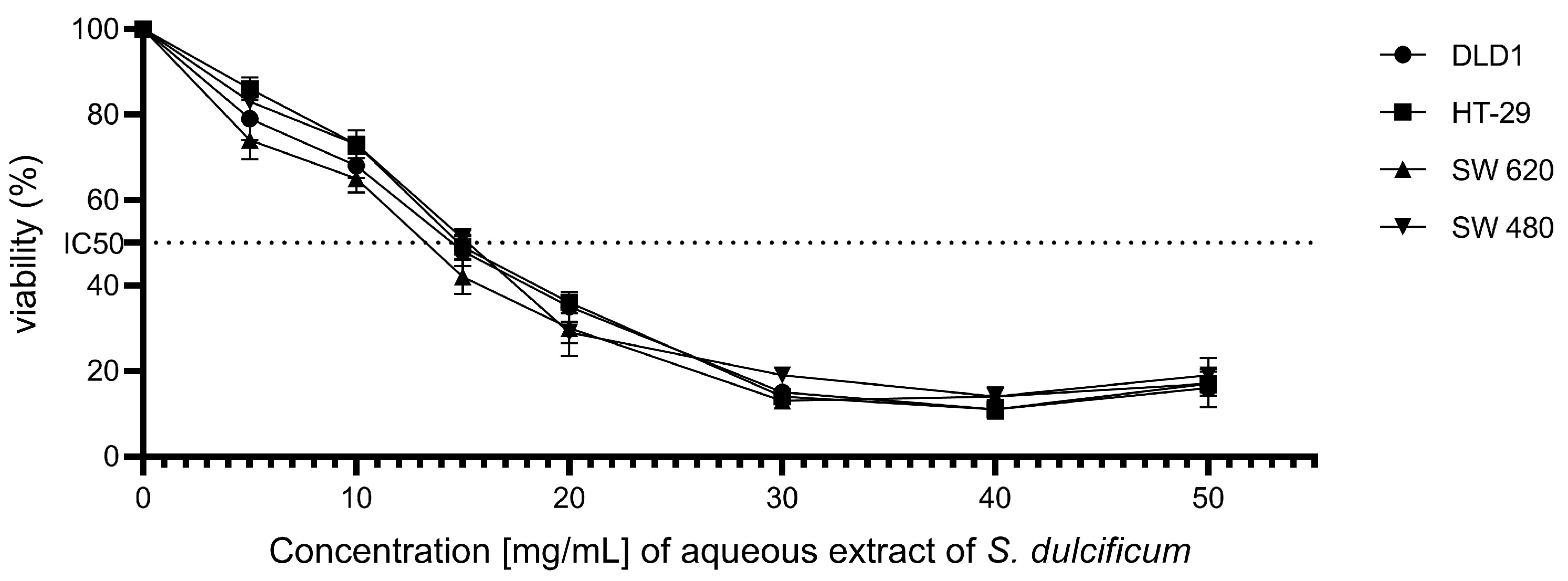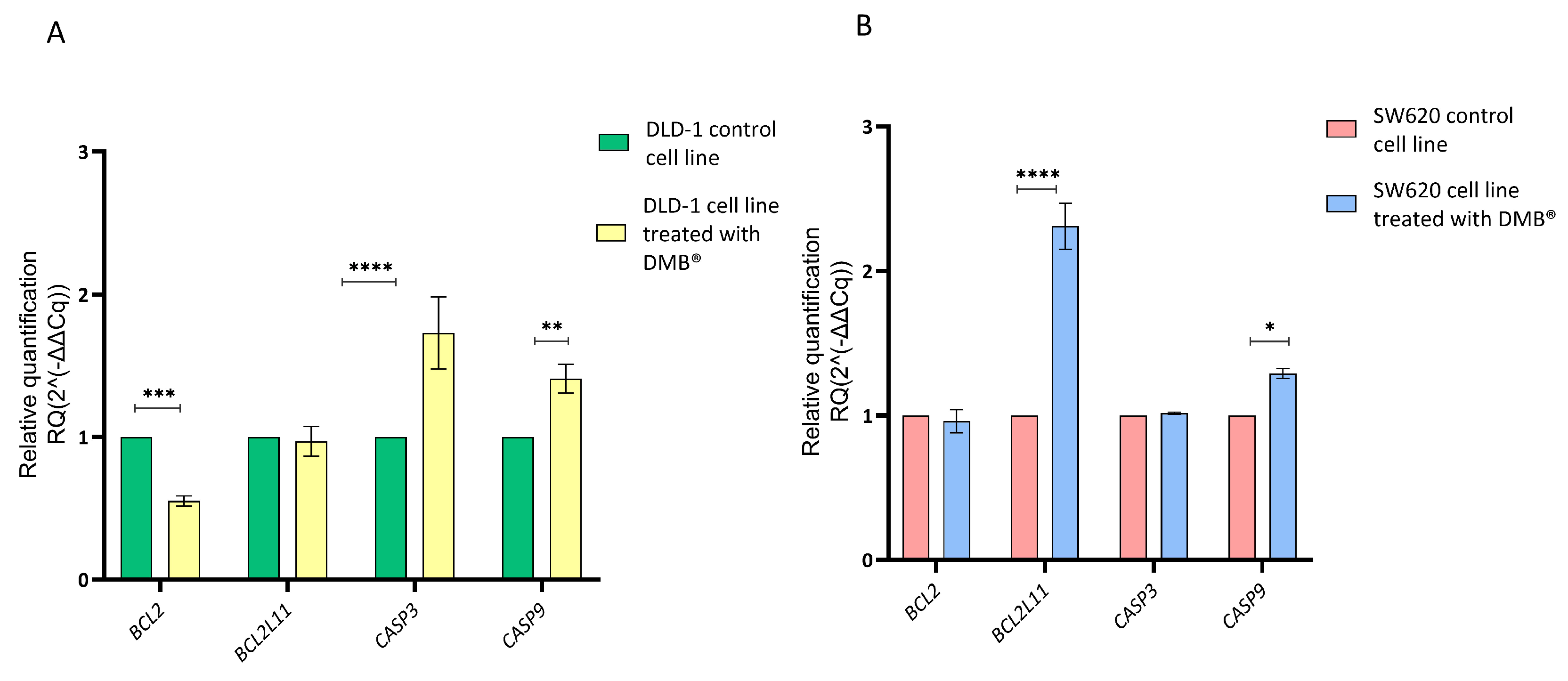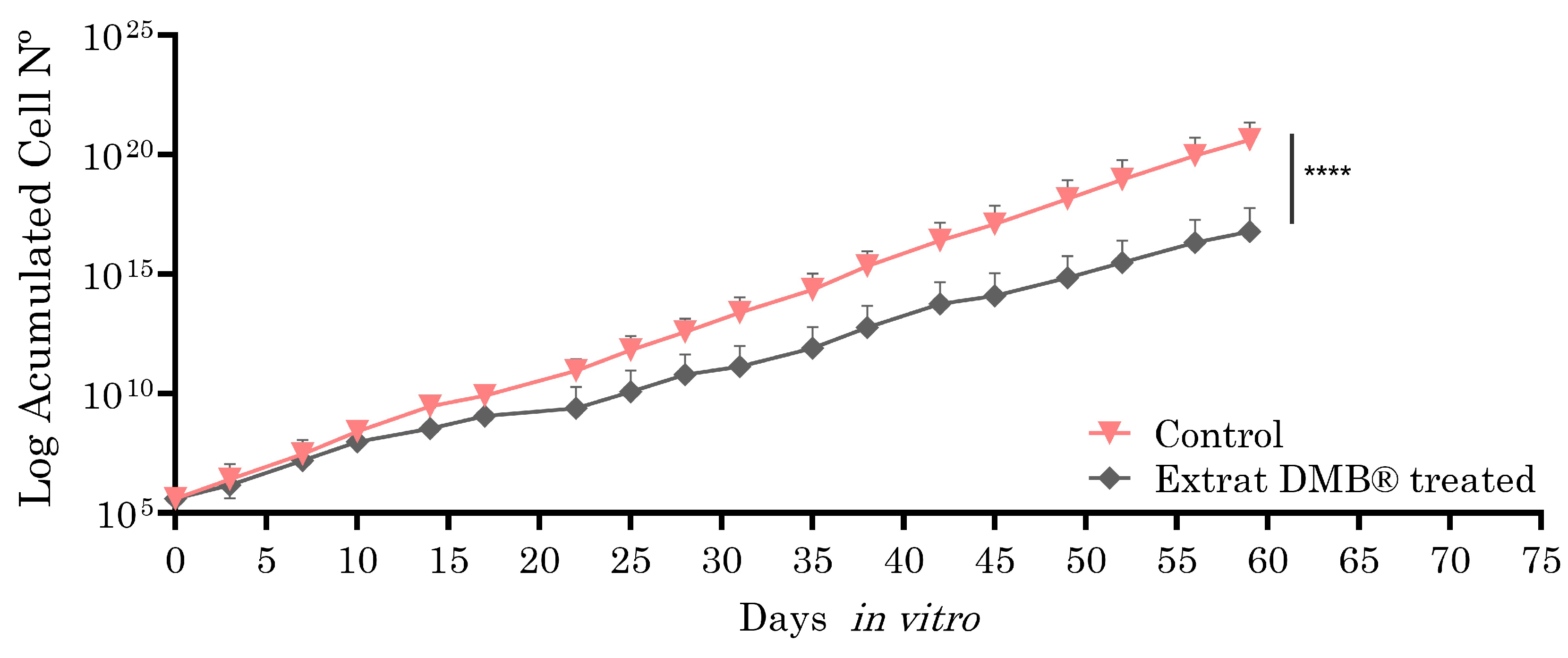Anticancer Potential, Phenolic Profile, and Antioxidant Properties of Synsepalum dulcificum (Miracle Berry) in Colorectal Tumor Cell Lines
Abstract
1. Introduction
2. Results
2.1. Quantification of Total Phenols and Antioxidant Capacity of the Aqueous Extract of DMB®
2.2. Chemical Characterization of DMB® Aqueous Extract
| Phenolic Compounds | Retention Time (min) | Standard Curve | Correlation Coefficient (r2) | Amount (µg/g WD) |
|---|---|---|---|---|
| Gallic acid | 5.4 | y = 81,204x − 5990.7 | R2 = 0.9997 | 174 ± 1 |
| Protocatechuic acid | 8.6 | y = 79,926x + 4177.5 | R2 = 0.9997 | 771 ± 2 |
| Catechin | 10.2 | y = 17,879x − 720.19 | R2 = 0.9997 | 145 ± 2 |
| Caffeic acid | 12.3 | y = 226,602x + 71,781 | R2 = 0.9986 | 0 |
| Syringic acid | 12.6 | y = 201,622x – 26,650 | R2 = 0.9997 | 2.17 ± 0.01 |
| Routine | 16.21 | y = 486,22x + 2371.2 | R2 = 0.9997 | 0 |
| Vanillin | 17.2 | y = 151,301x − 581.47 | R2 = 0.9998 | 0.36 ± 0.02 |
| Coumaric acid | 17.9 | y = 184,250x + 10,032 | R2 = 0.9997 | 9.49 ± 0.07 |
| Ferulic acid | 18.8 | y = 155,525x + 1518.5 | R2 = 0.9998 | 4.3 ± 0.2 |
| Salicylic acid | 22.9 | y = 24,793x − 1560.2 | R2 = 0.9997 | 2.7 ± 0.2 |
| Quercetin | 25.7 | y = 91,777x – 15,882 | R2 = 0.9996 | 2.92 ± 0.01 |
| Cinnamic acid | 27.3 | y = 234,241x + 2259.8 | R2 = 0.9998 | 0.32 ± 0.05 |
2.3. Antitumor Activity
2.3.1. Cell Viability
2.3.2. Effect of Chemotherapy in Combination with DMB®
2.3.3. Cell Cycle
2.3.4. QPCR Assay
2.3.5. Chronic Activity of DMB®
3. Discussion
3.1. Antioxidant
3.2. Extraction Phenolic
3.3. Analysis HPLC/GC-MS
3.4. Cellular Viability
3.5. Chemotherapy
3.6. Cell Cycle and qRT-PCR
3.7. Chronic Assays
4. Materials and Methods
4.1. Origin of Plant Materials
4.2. Total Phenol Extraction
4.3. Determination of Total Phenolic Content (TPC)
4.4. Determination of Antioxidant Activity Assays (TEAC) by DPPH•
4.5. Determination of Phenolic Composition by HPLC Analysis
4.6. GC/MS Chromatographic
4.7. Cell Assays
4.8. Cell Cycle: Propidium Iodide
4.9. qRT-PCR
4.9.1. RNA Extraction and cDNA Synthesis
4.9.2. Quantitative PCR (qPCR)
4.10. Chronification of Cells
4.10.1. Assay Chronification
4.10.2. Tumor Biomarker Analysis: Immunostaining
4.11. Statistical Analysis
5. Conclusions
Supplementary Materials
Author Contributions
Funding
Institutional Review Board Statement
Informed Consent Statement
Data Availability Statement
Acknowledgments
Conflicts of Interest
References
- Siegel, R.L.; Wagle, N.S.; Cercek, A.; Smith, R.A.; Jemal, A. Colorectal Cancer Statistics. CA Cancer J. Clin. 2023, 73, 233–254. [Google Scholar] [CrossRef]
- Liu, Q.; Guo, Z.; Li, G.; Zhang, Y.; Liu, X.; Li, B.; Wang, J.; Li, X. Cancer Stem Cells and Their Niche in Cancer Progression and Therapy. Cancer Cell Int. 2023, 23, 305. [Google Scholar] [CrossRef]
- Zainal Abidin, M.N.; Omar, M.S.; Islahudin, F.; Mohamed Shah, N. The Survival Impact of Palliative Chemotherapy Dose Modifications on Metastatic Colon Cancer. BMC Cancer 2022, 22, 731. [Google Scholar] [CrossRef]
- Yamamoto, S.; Fujii, H.; Murayama, K.; Iihara, H.; Watanabe, D.; Yamada, Y.; Kobayashi, R.; Kiyama, S.; Makiyama, A.; Urano, K.; et al. Efficacy and Safety of Oxaliplatin-Based Regimens as First-Line Chemotherapy in Elderly Patients With Metastatic Colorectal Cancer. Anticancer Res. 2023, 43, 5099–5105. [Google Scholar] [CrossRef]
- Fang, Y.; Sun, H.; Xiao, X.; Tang, M.; Tian, Z.; Wei, H.; Sun, R.; Zheng, X. Low-Dose Immunogenic Chemotherapeutics Promotes Immune Checkpoint Blockade in Microsatellite Stability Colon Cancer. Front. Immunol. 2022, 13, 1040256. [Google Scholar] [CrossRef]
- Zhang, Q.; Zhou, Y.; Feng, X.; Gao, Y.; Huang, C.; Yao, X. Low-Dose Orlistat Promotes the Therapeutic Effect of Oxaliplatin in Colorectal Cancer. Biomed. Pharmacother. 2022, 153, 113426. [Google Scholar] [CrossRef]
- Cragg, G.M.; Newman, D.J. Natural Products: A Continuing Source of Novel Drug Leads. Biochim. Biophys. Acta—Gen. Subj. 2013, 1830, 3670–3695. [Google Scholar] [CrossRef]
- De, S.; Paul, S.; Manna, A.; Majumder, C.; Pal, K.; Casarcia, N.; Mondal, A.; Banerjee, S.; Nelson, V.K.; Ghosh, S.; et al. Phenolic Phytochemicals for Prevention and Treatment of Colorectal Cancer: A Critical Evaluation of In Vivo Studies. Cancers 2023, 15, 993. [Google Scholar] [CrossRef]
- Kurihara, K.; Beidler, L.M. Taste-Modifying Protein from Miracle Fruit. Science 2017, 161, 1241–1243. [Google Scholar]
- Swamy, K.B.; Hadi, S.A.; Sekaran, M.; Pichika, M.R. The Clinical Effects of Synsepalum dulcificum: A Review. J. Med. Food 2014, 17, 1165–1169. [Google Scholar] [CrossRef]
- Verdier-Sévrain, S.; Bonté, F. Skin Hydration: A Review on Its Molecular Mechanisms. J. Cosmet. Dermatol. 2007, 6, 75–82. [Google Scholar] [CrossRef]
- Wagner, S.; Gómez de Cedrón, M.; Navarro del Hierro, J.; Martín-Hernández, D.; de Las Nieves Siles, M.; Santoyo, S.; Jaime, L.; Martín, D.; Fornari, T.; Ramírez de Molina, A. Biological Activities of Miracle Berry Supercritical Extracts as Metabolic Regulators in Chronic Diseases. Int. J. Mol. Sci. 2023, 24, 6957. [Google Scholar] [CrossRef]
- Gu, H.F.; Mao, X.Y.; Du, M. Prevention of Breast Cancer by Dietary Polyphenols—Role of Cancer Stem Cells. Crit. Rev. Food Sci. Nutr. 2020, 60, 810–825. [Google Scholar] [CrossRef]
- Skrovankova, S.; Sumczynski, D.; Mlcek, J.; Jurikova, T.; Sochor, J. Bioactive Compounds and Antioxidant Activity in Different Types of Berries. Int. J. Mol. Sci. 2015, 16, 24673–24706. [Google Scholar] [CrossRef]
- Haddad, S.G.; Mohammad, M.; Raafat, K.; Saleh, F.A. Antihyperglycemic and Hepatoprotective Properties of Miracle Fruit (Synsepalum dulcificum) Compared to Aspartame in Alloxan-Induced Diabetic Mice. J. Integr. Med. 2020, 18, 514–521. [Google Scholar] [CrossRef]
- Du, L.; Shen, Y.; Zhang, X.; Prinyawiwatkul, W.; Xu, Z. Antioxidant-Rich Phytochemicals in Miracle Berry (Synsepalum dulcificum) and Antioxidant Activity of Its Extracts. Food Chem. 2014, 153, 279–284. [Google Scholar] [CrossRef]
- Shafiee, F.; Safaeian, L.; Gorbani, F. Protective Effects of Protocatechuic Acid against Doxorubicin-and Arsenic Trioxide-Induced Toxicity in Cardiomyocytes. Res. Pharm. Sci. 2023, 18, 149–158. [Google Scholar] [CrossRef]
- Khan, A.K.; Rashid, R.; Fatima, N.; Mahmood, S.; Mir, S.; Khan, S.; Jabeen, N.; Murtaza, G. Pharmacological Activities of Protocatechuic Acid. Acta Pol. Pharm. 2015, 72, 643–650. [Google Scholar]
- Chen, Q.; Liu, T.; Bai, T.; Zhang, M.; Hu, Y.; Li, J.; Chang, F. Mechanism of Synsepalum dulcificum Daniell. Inhibiting Lung Adenocarcinoma. Evid. Based Complement. Alternat. Med. 2022, 2022, 5242179. [Google Scholar] [CrossRef]
- Behera, P.; Balaji, S. The Forgotten Sugar: A Review on Multifarious Applications of Melezitose. Carbohydr. Res. 2021, 500, 108248. [Google Scholar] [CrossRef]
- Plaza-Oliver, M.; Beloqui, A.; Santander-Ortega, M.J.; Castro-Vázquez, L.; Rodríguez-Robledo, V.; Arroyo-Jiménez, M.M.; Préat, V.; Lozano, M.V. Ascorbyl-Dipalmitate-Stabilised Nanoemulsions as a Potential Localised Treatment of Inflammatory Bowel Diseases. Int. J. Pharm. 2020, 586, 119533. [Google Scholar] [CrossRef]
- Niu, L.; Li, W.; Chen, X.; Su, X.; Dong, J.; Liao, Q.; Zhou, X.; Shi, S.; Sun, R. 1-Monopalmitin Promotes Lung Cancer Cells Apoptosis through PI3K/Akt Pathway in Vitro. Environ. Toxicol. 2023, 38, 2621–2631. [Google Scholar] [CrossRef]
- Becker, L.C.; Bergfeld, W.F.; Belsito, D.V.; Hill, R.A.; Klaassen, C.D.; Liebler, D.C.; Marks, J.G.; Shank, R.C.; Slaga, T.J.; Snyder, P.W.; et al. Safety Assessment of Glycerin as Used in Cosmetics. Int. J. Toxicol. 2019, 38, 6S–22S. [Google Scholar] [CrossRef]
- Aparna, V.; Dileep, K.V.; Mandal, P.K.; Karthe, P.; Sadasivan, C.; Haridas, M. Anti-Inflammatory Property of n-Hexadecanoic Acid: Structural Evidence and Kinetic Assessment. Chem. Biol. Drug Des. 2012, 80, 434–439. [Google Scholar] [CrossRef]
- Johra, F.T.; Hossain, S.; Jain, P.; Bristy, A.T.; Emran, T.; Ahmed, R.; Sharker, S.M.; Bepari, A.K.; Reza, H.M. Amelioration of CCl4-Induced Oxidative Stress and Hepatotoxicity by Ganoderma Lucidum in Long Evans Rats. Sci. Rep. 2023, 13, 9909. [Google Scholar] [CrossRef]
- Zou, R.; Zhou, K.; Stephanopoulos, G.; Too, H.P. Combinatorial Engineering of 1-Deoxy-D-Xylulose 5-Phosphate Pathway Using Cross-Lapping in Vitro Assembly (CLIVA) Method. PLoS ONE 2013, 8, e79557. [Google Scholar] [CrossRef]
- Moon, H.J.; Jeya, M.; Kim, I.W.; Lee, J.K. Biotechnological Production of Erythritol and Its Applications. Appl. Microbiol. Biotechnol. 2010, 86, 1017–1025. [Google Scholar]
- Seong, J.; Oyong, G.G.; Cabrera, E.C. Synsepalum dulcificum Extracts Exhibit Cytotoxic Activity on Human Colorectal Cancer Cells and Upregulate C-Fos and c-Jun Early Apoptotic Gene Expression. Asian Pac. J. Trop. Biomed. 2018, 8, 173–178. [Google Scholar] [CrossRef]
- Olejnik, A.; Olkowicz, M.; Kowalska, K.; Rychlik, J.; Dembczyński, R.; Myszka, K.; Juzwa, W.; Białas, W.; Moyer, M.P. Gastrointestinal Digested Sambucus nigra L. Fruit Extract Protects in Vitro Cultured Human Colon Cells against Oxidative Stress. Food Chem. 2016, 197, 648–657. [Google Scholar] [CrossRef]
- Jiang, Y.; Pei, J.; Zheng, Y.; Miao, Y.; Duan, B.; Huang, L. Gallic Acid: A Potential Anti-Cancer Agent. Chin. J. Integr. Med. 2022, 28, 661–671. [Google Scholar] [CrossRef]
- Nirgude, S.; Desai, S.; Choudhary, B. Curcumin Alters Distinct Molecular Pathways in Breast Cancer Subtypes Revealed by Integrated MiRNA/MRNA Expression Analysis. Cancer Rep. 2022, 5, e1596. [Google Scholar] [CrossRef]
- Pundalik, S.; Hanumappa, K.R.; Giresha, A.S.; Urs, D.; Rajashekarappa, S.; Muniyappa, N.; Jamballi, G.M.; Shivanna, D.K.; Meti, R.S.; Setty, S.A.D.; et al. Corosolic Acid Inhibits Secretory Phospholipase A2IIa as an Anti-Inflammatory Function and Exhibits Anti-Tumor Activity in Ehrlich Ascites Carcinoma Bearing Mice. J. Inflamm. Res. 2022, 15, 6905–6921. [Google Scholar] [CrossRef] [PubMed]
- Hussar, P. Apoptosis Regulators Bcl-2 and Caspase-3. Encylopedia 2022, 2, 1624–1636. [Google Scholar] [CrossRef]
- Song, D.; Lian, Y.; Zhang, L. The Potential of Activator Protein 1 (AP-1) in Cancer Targeted Therapy. Front. Immunol. 2023, 14, 1224892. [Google Scholar] [CrossRef]
- Fujie, Y.; Yamamoto, H.; Ngan, C.Y.; Takagi, A.; Hayashi, T.; Suzuki, R.; Ezumi, K.; Takemasa, I.; Ikeda, M.; Sekimoto, M.; et al. Oxaliplatin, a Potent Inhibitor of Survivin, Enhances Paclitaxel-Induced Apoptosis and Mitotic Catastrophe in Colon Cancer Cells. Jpn. J. Clin. Oncol. 2005, 35, 453–463. [Google Scholar] [CrossRef] [PubMed]
- Matuo, R.; Sousa, F.G.; Escargueil, A.E.; Grivicich, I.; Garcia-Santos, D.; Chies, J.A.B.; Saffi, J.; Larsen, A.K.; Pêgas Henriquesa, J.A. 5-Fluorouracil and Its Active Metabolite FdUMP Cause DNA Damage in Human SW620 Colon Adenocarcinoma Cell Line. J. Appl. Toxicol. 2009, 29, 308–316. [Google Scholar] [CrossRef] [PubMed]
- Baby, B.; Antony, P.; Vijayan, R. Antioxidant and Anticancer Properties of Berries. Crit. Rev. Food Sci. Nutr. 2018, 58, 2491–2507. [Google Scholar] [CrossRef]
- Sánchez-Díez, M.; Alegría-Aravena, N.; López-Montes, M.; Quiroz-Troncoso, J.; González-Martos, R.; Menéndez-Rey, A.; Sánchez-Sánchez, J.L.; Pastor, J.M.; Ramírez-Castillejo, C. Implication of Different Tumor Biomarkers in Drug Resistance and Invasiveness in Primary and Metastatic Colorectal Cancer Cell Lines. Biomedicines 2022, 10, 1083. [Google Scholar] [CrossRef]
- Singleton, V.L.; Orthofer, R.; Lamuela-Raventós, R.M. Analysis of Total Phenols and Other Oxidation Substrates and Antioxidants by Means of Folin-Ciocalteu Reagent. Methods Enzymol. 1999, 299, 152–178. [Google Scholar] [CrossRef]
- Bondet, V.; Brand-Williams, W.; Berset, C. Kinetics and mechanisms of antioxidant activity using the DPPH free radical method. Lebensmitt Wissenschaft Technologie Food Sci. Technol. 1997, 30, 609–615. [Google Scholar] [CrossRef]






| DPPH | ||||
|---|---|---|---|---|
| Total Phenols (mg GAE/mg Dry Extract) | Total Flavonoids (mg QE/mg Dry Extract) | µmol Trolox/gr Dry Extract | % Inhibition | |
| DMB® | 9.7 ± 0.5 | 3.3 ± 0.2 | 64 ± 2 | 37 ± 1 |
| P. domestica | 4.1 ± 0.1 | 2.3 ± 0.4 | 35 ± 2 | 20 ± 1 |
| P. persica | 1.35 ± 0.05 | 2.3 ± 0.3 | 4.0 ± 06 | 2.9 ± 0.7 |
| Peak | Retiention Time | Option 1 | Molecular Formula | InChIKey | Option 2 | Molecular Formula | InChIKey | Option 3 | Molecular Formula | InChIKey |
|---|---|---|---|---|---|---|---|---|---|---|
| 1 | 5.14 | Glycerin | C3H8O3 | PEDCQBHIVMGVHV-UHFFFAOYSA-N | 3-Methoxy-2,2-dimethyloxirane | C5H10O2 | FPKWGRVMLLIFSY-UHFFFAOYSA-N | p-Dioxane-2,3-diol | C4H8O4 | YLVACWCCJCZITJ-UHFFFAOYSA-N |
| 2 | 6 | Propanoic acid, 2-oxo-, methyl ester | C4H6O3 | CWKLZLBVOJRSOM-UHFFFAOYSA-N | 3-Amino-2-oxazolidinone | C3H6N2O2 | KYCJNIUHWNJNCT-UHFFFAOYSA-N | Ethyl acetoxycarbamate | C5H9NO4 | PWDCNDKCDGSDGY-UHFFFAOYSA-N |
| 3 | 7.27 | 2-Furanmethanol | C5H6O2 | XPFVYQJUAUNWIW-UHFFFAOYSA-N | 3-Furanmethanol | C5H6O2 | STJIISDMSMJQQK-UHFFFAOYSA-N | Methylenecyclopropanecarboxylic acid | C5H6O2 | QJUQASYVMKRUMN-UHFFFAOYSA-N |
| 4 | 9.38 | 2,4-Dihydroxy-2,5-dimethyl-3(2H)-furan-3-one | C6H8O4 | JYMIRUWYSKOKRU-UHFFFAOYSA-N | 4H-Pyran-4-one, 2,3-dihydro-3,5-dihydroxy-6-methyl- | C6H8O4 | JYMIRUWYSKOKRU-UHFFFAOYSA-N | N-(1-Methoxycarbonyl-1-methylethyl)-4-methyl-2-aza-1,3-dioxane | C9H17NO4 | VWGVVWKWTUQAIE-UHFFFAOYSA-N |
| 5 | 10.65 | 2,5-Dimethylfuran-3,4(2H,5H)-dione | C6H8O3 | PUVDDHUFFRRFMN-UHFFFAOYSA-N | Furaneol | C6H8O3 | INAXVXBDKKUCGI-UHFFFAOYSA-N | 2,5-Piperazinedione, 3-methyl- | C5H8N2O2 | ICCHEGCKVBMSTF-UHFFFAOYSA-N |
| 6 | 11.94 | 4H-Pyran-4-one, 2,3-dihydro-3,5-dihydroxy-6-methyl- | C6H8O4 | VOLMSPGWNYJHQQ-UHFFFAOYSA-N | 2,4-Dihydroxy-2,5-dimethyl-3(2H)-furan-3-one | C6H8O4 | JYMIRUWYSKOKRU-UHFFFAOYSA-N | 2-Propyl-tetrahydropyran-3-ol | C8H16O2 | SMMBPJGNKCWQPY-UHFFFAOYSA-N |
| 7 | 12.96 | 5-Hydroxymethylfurfural | C6H6O3 | NOEGNKMFWQHSLB-UHFFFAOYSA-N | Furan, 2,3-dihydro-4-(1-methylpropyl)-, (S)- | C8H14O | UQEZSQDDLZCNRH-ZETCQYMHSA-N | 4-Mercaptophenol | C6H6OS | BXAVKNRWVKUTLY-UHFFFAOYSA-N |
| 8 | 13.36 | 2-Oxepanone, 7-hexyl- | C12H22O2 | FRTMRFCNTDDSOB-UHFFFAOYSA-N | Caprolactam | C6H11NO | JBKVHLHDHHXQEQ-UHFFFAOYSA-N | 2-Oxepanone, 7-butyl- | C10H18O2 | YKVIWISPFDZYOW-UHFFFAOYSA-N |
| 9 | 13.69 | Octanamide, N-(2-mercaptoethyl)- | C10H21NOS | JLZORHOCSVVPHT-UHFFFAOYSA-N | Maltose | C12H22O11 | GUBGYTABKSRVRQ-QUYVBRFLSA-N | 6-oxoheptanoato de metilo | C8H14O3 | BSBYQAYWPXHLPQ-UHFFFAOYSA-N |
| 10 | 15.67 | Melezitose | C18H32O16 | QWIZNVHXZXRPDR-WSCXOGSTSA-N | Maltose | C12H22O11 | GUBGYTABKSRVRQ-QUYVBRFLSA-N | Lactose | C12H22O11 | GUBGYTABKSRVRQ-DCSYEGIMSA-N |
| 11 | 16.42 | 2,6-Diamino-4-cyclohexyl-4H-thiopyran-3,5-dicarbonitrile | C13H16N4S | RBAOYVGXTOUWKG-UHFFFAOYSA-N | Cyclohexane, 1,4-dimethyl-2-octadecyl- | C26H52 | IYAUESUIHMJWPO-UHFFFAOYSA-N | Octa-2,6-diene, 2,7-dimethyl-4-phenylthio- | C16H22S | OTLKSJYKRHNQQB-UHFFFAOYSA-N |
| 12 | 19.82 | Hexadecanoic acid, methyl ester | C17H34O2 | FLIACVVOZYBSBS-UHFFFAOYSA-N | Pentadecanoic acid, 13-methyl-, methyl ester | C17H34O2 | FRGDXZRZDAJTOU-UHFFFAOYSA-N | Pentadecanoic acid, 14-methyl-, methyl ester | C17H34O2 | WAKCWJNDXBPEBP-UHFFFAOYSA-N |
| 13 | 20.11 | l-(+)-Ascorbic acid 2,6-dihexadecanoate | C38H68O8 | TUYRNAGGIJZRNM-LBHUVFDKSA-N | n-Hexadecanoic acid | C16H32O2 | IPCSVZSSVZVIGE-UHFFFAOYSA-N | Pentadecanoic acid | C15H30O2 | WQEPLUUGTLDZJY-UHFFFAOYSA-N |
| 14 | 21.68 | Octadecanoic acid | C18H36O2 | QIQXTHQIDYTFRH-UHFFFAOYSA-N | Octadecanoic acid, 2-(2-hydroxyethoxy)ethyl ester | C22H44O4 | PWVUXRBUUYZMKM-UHFFFAOYSA-N | L-Ascorbic acid, 6-octadecanoate | C24H42O7 | LITUBCVUXPBCGA-WMZHIEFXSA-N |
| 15 | 24.26 | Hexadecanoic acid, 2-hydroxy-1-(hydroxymethyl)ethyl ester | C19H38O4 | BBNYCLAREVXOSG-UHFFFAOYSA-N | Glycerol 1-palmitate | C19H38O4 | QHZLMUACJMDIAE-UHFFFAOYSA-N | Hexadecanoic acid, 1-(hydroxymethyl)-1,2-ethanediyl ester | C35H68O5 | JEJLGIQLPYYGEE-UHFFFAOYSA-N |
| DLD-1 | HT-29 | SW620 | SW480 | 293T | ||||||
|---|---|---|---|---|---|---|---|---|---|---|
| Oxaliplatin | Oxaliplatin + DMB® | Oxaliplatin | Oxaliplatin + DMB® | Oxaliplatin | Oxaliplatin + DMB® | Oxaliplatin | Oxaliplatin + DMB® | Oxaliplatin | Oxaliplatin + DMB® | |
| IC50 | 57 | 13 | 14 | 25 | 6.2 | 4.4 | 8.6 | 11 | 15 | 2 |
| logIC50 | 1.75 | 1.11 | 1.13 | 1.39 | 0.79 | 0.64 | 0.93 | 1.02 | 1.16 | 0.22 |
Disclaimer/Publisher’s Note: The statements, opinions and data contained in all publications are solely those of the individual author(s) and contributor(s) and not of MDPI and/or the editor(s). MDPI and/or the editor(s) disclaim responsibility for any injury to people or property resulting from any ideas, methods, instructions or products referred to in the content. |
© 2025 by the authors. Licensee MDPI, Basel, Switzerland. This article is an open access article distributed under the terms and conditions of the Creative Commons Attribution (CC BY) license (https://creativecommons.org/licenses/by/4.0/).
Share and Cite
Quiroz-Troncoso, J.; Alegría-Aravena, N.; Sáenz de Mierae, B.; Sánchez-Díez, M.; González-Martos, R.; Gavira-O’Neill, C.E.; González, E.J.; González-Miquel, M.; Valdés Vergara, C.; González-Silva, G.; et al. Anticancer Potential, Phenolic Profile, and Antioxidant Properties of Synsepalum dulcificum (Miracle Berry) in Colorectal Tumor Cell Lines. Antioxidants 2025, 14, 381. https://doi.org/10.3390/antiox14040381
Quiroz-Troncoso J, Alegría-Aravena N, Sáenz de Mierae B, Sánchez-Díez M, González-Martos R, Gavira-O’Neill CE, González EJ, González-Miquel M, Valdés Vergara C, González-Silva G, et al. Anticancer Potential, Phenolic Profile, and Antioxidant Properties of Synsepalum dulcificum (Miracle Berry) in Colorectal Tumor Cell Lines. Antioxidants. 2025; 14(4):381. https://doi.org/10.3390/antiox14040381
Chicago/Turabian StyleQuiroz-Troncoso, Josefa, Nicolás Alegría-Aravena, Blanca Sáenz de Mierae, Marta Sánchez-Díez, Raquel González-Martos, Clara E. Gavira-O’Neill, Emilio J. González, Maria González-Miquel, Cristian Valdés Vergara, Gloria González-Silva, and et al. 2025. "Anticancer Potential, Phenolic Profile, and Antioxidant Properties of Synsepalum dulcificum (Miracle Berry) in Colorectal Tumor Cell Lines" Antioxidants 14, no. 4: 381. https://doi.org/10.3390/antiox14040381
APA StyleQuiroz-Troncoso, J., Alegría-Aravena, N., Sáenz de Mierae, B., Sánchez-Díez, M., González-Martos, R., Gavira-O’Neill, C. E., González, E. J., González-Miquel, M., Valdés Vergara, C., González-Silva, G., Bensadon-Naeder, L., Galeano, J., & Ramírez-Castillejo, C. (2025). Anticancer Potential, Phenolic Profile, and Antioxidant Properties of Synsepalum dulcificum (Miracle Berry) in Colorectal Tumor Cell Lines. Antioxidants, 14(4), 381. https://doi.org/10.3390/antiox14040381











